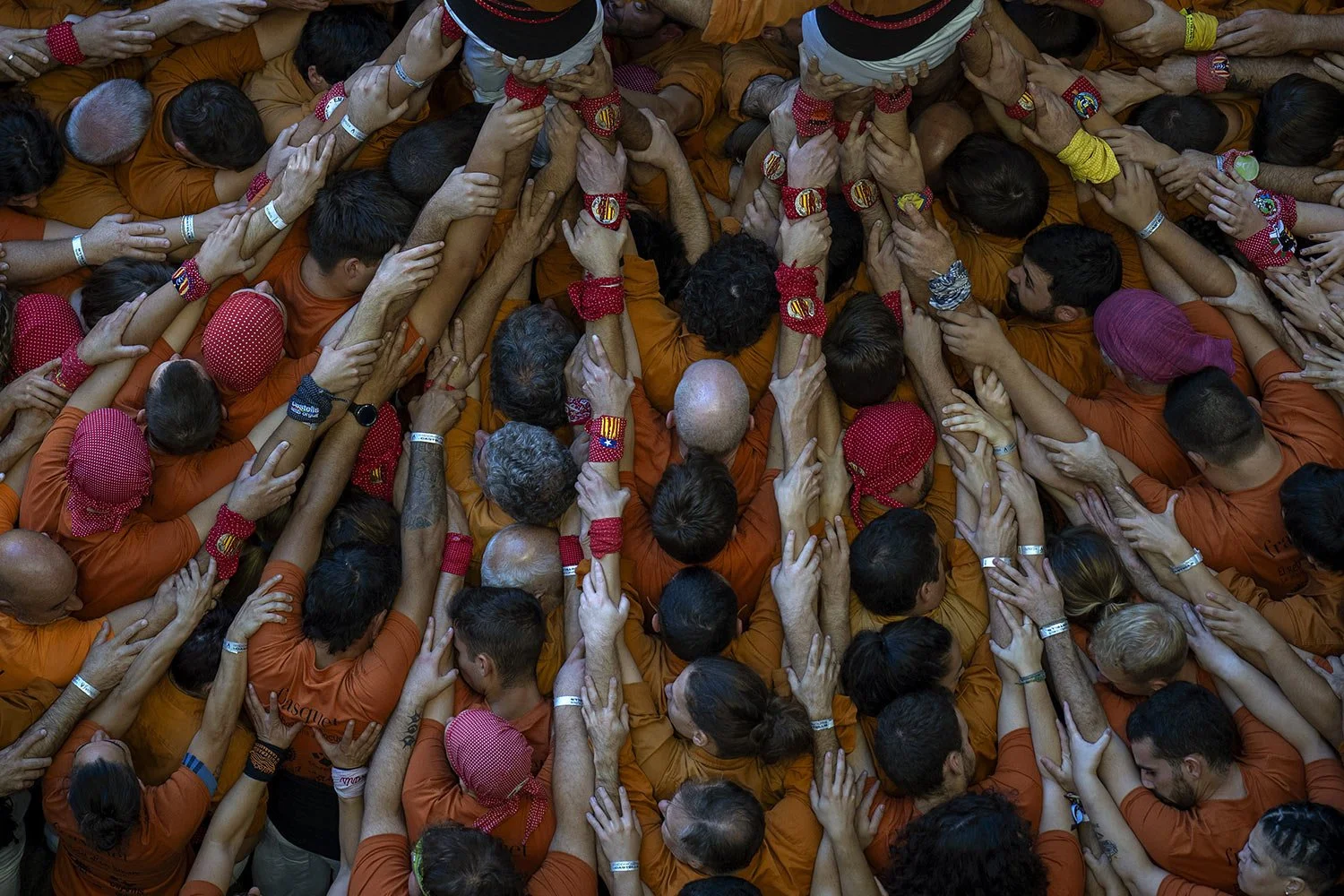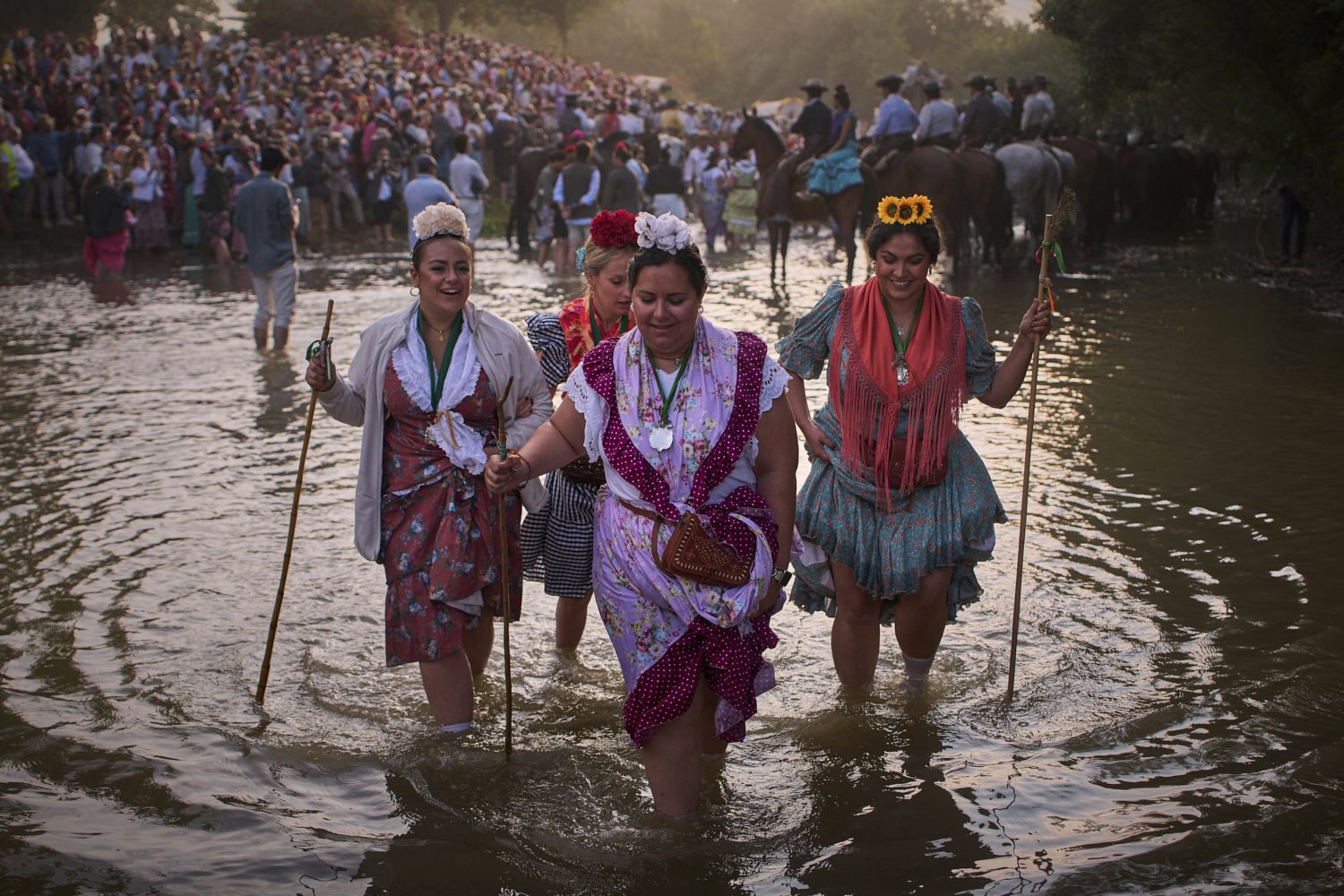Human towers rise skyward in Spain's Catalonia as part of cultural pride

Dozens of people squeeze together, pressing as tight as they can get. The stronger the foundation they build, the less likely their human tower will collapse. As children and others climb, they create eight, nine, even 10 dizzying stories.
They tug on sashes wound around torsos, gritting their teeth to keep their backs straight and their legs from buckling. With maximum concentration, they look into each other’s eyes, seeking further support.
The tradition of building human towers, or “castells” in Catalan, dates to the 18th century and forms an essential part of Catalonia’s culture. “Colles,” or human tower troupes, compete to build the tallest and most complicated towers at festivals often held in village squares across the region in northeastern Spain.
Members of "Castellers de Sant Cugat" react after successfully completing their "Castell", during the 29th Human Tower Competition in Tarragona, Spain, Saturday, Oct. 5, 2024. (AP Photo/Emilio Morenatti)
Members of "Moixiganguers d'Igualada" form a "Castell" or human tower, during the 29th Human Tower Competition in Tarragona, Spain, Sunday, Oct. 6, 2024. (AP Photo/Emilio Morenatti)
For many Catalans, the towers symbolize the pride they feel for their land, language and history. It means they are in it together and, if united, they are capable of amazing feats.
As the tower goes up, the ages come down. Graying hair, receding hairlines and the burliest bodies are seen on the ground floor. The increasingly nimble are tasked with creating the final stages. Young men and women, then teenagers, then children ascend in a spidery climb, their arms interlocked, to the very top.
The smallest boy or girl, as young as 5 years old, crowns the tower, reaching some 16 meters high (52 feet). Then, as collective strength wavers, the tower often sways. It undoes itself, with each level sliding down the backs of lower ones.
Or the tower crashes on the heads and shoulders below. Injuries aren't common, and children wear helmets.
Assistants look as members of a "Castellers" form a human tower, during the 29th Human Tower Competition in Tarragona, Spain, Saturday, Oct. 5, 2024. (AP Photo/Emilio Morenatti)
Members of "Colla Jove de Tarragona" form a "Castell" or human tower, during the 29th Human Tower Competition in Tarragona, Spain, Sunday, Oct. 6, 2024. (AP Photo/Emilio Morenatti)
Every two years, the most important competition for human towers is held in Tarragona, an old Roman city on the Mediterranean coast. The “Concurs de Castells” started in 1932. It now invites the 42 best teams to compete.
Newcomers and foreigners alike now take part in this practice that's included in UNESCO's list of Intangible Cultural Heritage.
Tomoko Sakamoto is from Japan. She, her husband and their two children participate in a human tower troupe.
“It’s changed my life,” she said. “I am part of Catalan culture and I am proud.”
Members of "Castellers de la Vila de Gracia" form a "Castell" or human tower, during the 29th Human Tower Competition in Tarragona, Spain, Saturday, Oct. 5, 2024. (AP Photo/Emilio Morenatti)
Assistants look as members of "Castellers Jove de Barcelona" form a "Castell" or human tower, during the 29th Human Tower Competition in Tarragona, Spain, Saturday, Oct. 5, 2024. (AP Photo/Emilio Morenatti)
Members of "Colla Joves Xiquets de Valls" react as they form a "Castell" or human tower, during the 29th Human Tower Competition in Tarragona, Spain, Sunday, Oct. 6, 2024. (AP Photo/Emilio Morenatti)
Member of "Castellers de Vilafranca" form a "Castell" or human tower, during the 29th Human Tower Competition in Tarragona, Spain, Sunday, Oct. 6, 2024. (AP Photo/Emilio Morenatti)
Valeria, 11, reacts after climbing to the top of a "castell" or human tower during the 29th Human Tower Competition in Tarragona, Spain, Saturday, Oct. 5, 2024. (AP Photo/Emilio Morenatti)
Members of "Colla Jove de Tarragona" fall before completing a "Castell" or human tower, during the 29th Human Tower Competition in Tarragona, Spain, Sunday, Oct. 6, 2024. (AP Photo/Emilio Morenatti)
Assistants react as members of "Castellers de Vilafranca" try to form a "Castell" or human tower, during the 29th Human Tower Competition in Tarragona, Spain, Sunday, Oct. 6, 2024. (AP Photo/Emilio Morenatti)
Members of "Sagals d'Osona" form a "Castell" or human tower, during the 29th Human Tower Competition in Tarragona, Spain, Saturday, Oct. 5, 2024. (AP Photo/Emilio Morenatti)
Juan Antonio Rodriguez, 72, reacts after performing next to members of "Castellers de Vilafranca" completing a "Castell" or human tower, during the 29th Human Tower Competition in Tarragona, Spain, Sunday, Oct. 6, 2024. (AP Photo/Emilio Morenatti)
Members of "Castellers de Lleida" celebrate after successfully completing a "castells" or human tower, during the 29th Human Tower Competition in Tarragona, Spain, Saturday, Oct. 5, 2024. (AP Photo/Emilio Morenatti)
Members of "Colla Joves Xiquets de Valls" fall as they try to form a "Castell" or human tower, during the 29th Human Tower Competition in Tarragona, Spain, Sunday, Oct. 6, 2024. (AP Photo/Emilio Morenatti)
Members of "Castellers de Vilafranca" celebrate after completing a "Castell" or human tower, during the 29th Human Tower Competition in Tarragona, Spain, Sunday, Oct. 6, 2024. (AP Photo/Emilio Morenatti)
The torn shirt of an assistant is photographed after completing a "Castellers" or human tower during the 29th Human Tower Competition in Tarragona, Spain, Saturday, Oct. 5, 2024. (AP Photo/Emilio Morenatti)
Text from AP News story, Human towers rise skyward in Spain's Catalonia as part of cultural pride, by Emilio Morenatti
Photos by Emilio Morenatti







